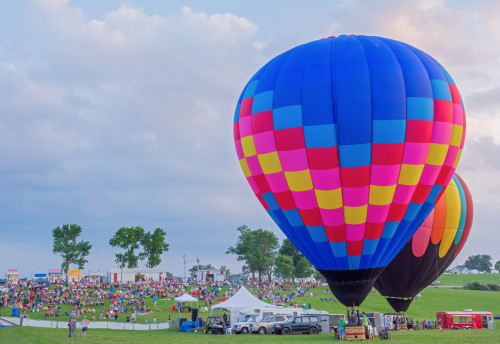
Photo by Angelina Peace
By Ashley Rullestad
Though brothers Joseph-Michel and Jacques-Etienne Montgolfier in Annonay, France, are credited with successfully launching the first free flight hot air balloon carrying human passengers in 1783, the invention of the first modern hot air balloon and the popularity of competitive ballooning is tethered to mid-20th century Iowa.
Gas-powered dirigibles made appearances in Iowa in the early 1900s at county fairs and other events. Some were shaped like teardrop hot air balloons seen today floating over Iowa, while others were designed like airships with propellers. Most, however, were crude by today’s standards as pilots often had to parachute to the ground as they were unable to control their landings.
Improved safety, maneuverability and distance were ushered in when the first modern hot air balloon was developed in 1960 by a native Iowan inventor.
Paul E. “Ed” Yost, who was born in Bristow in 1919, is considered the father of modern ballooning. He devoted his life to flying, particularly balloons. He was employed by the U.S. Army Air Corps from 1943 to 1945; he flew airplanes in Alaska after the war until 1948; and in 1949 worked as a senior engineer and tracking pilot for the High Altitude Research Division of General Mills in Minneapolis, Minn., where he worked on many scientific high altitude balloon projects, including launching a 3.2 million-cubic-foot balloon carrying U.S. Navy instruments into the stratosphere to study cosmic rays in 1952.
Four years later, Yost and three others from General Mills formed Raven Industries. The U.S. Navy Office of Naval Research commissioned Raven Industries in Sioux Falls, S.D., to develop a hot air balloon capable of carrying one man and enough fuel to fly for up to three hours, reach an altitude of 10,000 feet and be reusable.
He worked with gasoline, kerosene, coal, oil and other fuels until he found propane worked best. It’s what pilots still use today.
“The first balloon didn’t have a basket; just a seat that looked like a lawn chair,” said Becky Wigeland, director of the National Balloon Museum in Indianola and co-author of “Indianola: Ballooning Capital of Iowa.” “It had upside down tanks on two sides and a small burner. It totally changed ballooning because they’d never had something that was reusable, and the only balloons people then had seen were gas balloons.”
The new balloon, with a nylon envelope, had its first flight in Bruning, Neb., on Oct. 22, 1960. Yost went on to develop a number of items related to ballooning, and he held 21 patents on balloons and lighter-than-air mechanisms. Among them, was a lightweight, disposable balloon that was used to send U.S. leaflets behind the Iron Curtain during the Cold War and a balloon that carried a camera to photograph enemy territories. Another invention of his was a fast-deploying parachute used to deliver supplies to U.S. troops during the Vietnam War. He never sought compensation for his inventions because he saw them as necessary to solve problems and create techniques and devices that would make ballooning safer and possible.
Just three years after his invention, Yost and Don Piccard flew a modern hot air balloon nicknamed “Channel Champ” over the English Channel from England to France in a little more than three hours. The publicity generated by the flight brought worldwide attention to the fact that dependable, practical and relatively inexpensive balloons were now accessible to anyone.
Almost immediately, a new sport was born thanks to Yost. In 1961, the Balloon Federation of America, the ruling body of balloonists in the United States, was developed. The first National Hot Air Balloon Championship was held in Michigan in 1963 and the rest, as they say, is history.
Ballooning takes flight in Iowa
The first person in Iowa to own a modern balloon was an attorney from Fort Dodge named Don Kersten. He purchased a balloon from Piccard, who brought it to Iowa in July 1965 and taught him how to fly it.
“After three lessons, Piccard told him, ‘Ok, you’ve got your license,’” Wigeland said with a laugh.
The balloon was named “Merope” after his wife and that year he competed in the U.S. National Championships where he took third place. In the late 1960s, he was one of about a dozen hot air balloonists in the U.S. and he was instrumental in bringing the U.S. National Championships to Iowa.
TO READ MORE ABOUT THIS STORY AND OTHER FASCINATING STORIES ABOUT IOWA HISTORY, subscribe to Iowa History Journal. You can also purchase back issues at the store.
